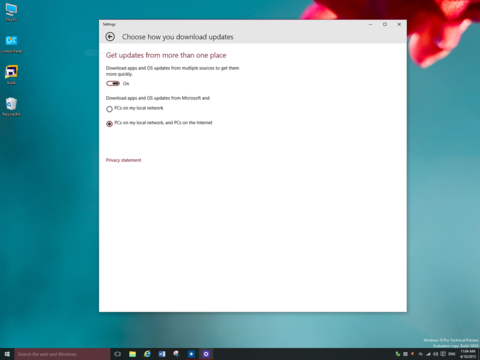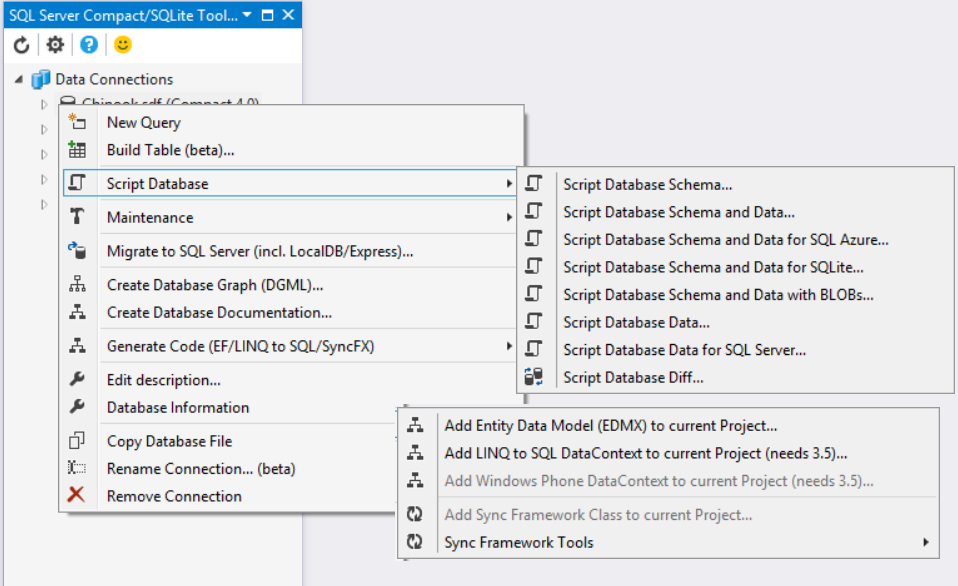Dec 13, 2015 How to use SQL Server Compact 4.0 in Visual Studio 2015 Community (no voice) - ATTENTION - SQL SERVER COMPACT IS NOT INTENDED TO ASP.NET (;( ) - Try different type of project. Use the Visual Studio debugger to quickly find and fix bugs across languages. The Visual Studio for Mac debugger lets you step inside your code by setting Breakpoints, Step Over statements, Step Into and Out of functions, and inspect the current state of the code stack through powerful visualizations.
Microsoft SQL Server Compact (SQL CE) is a compactrelational database produced by Microsoft for applications that run on mobile devices and desktops. Prior to the introduction of the desktop platform, it was known as SQL Server for Windows CE and SQL Server Mobile Edition.
It includes both 32-bit and 64-bit native support.[1] SQL CE targets occasionally connected applications and applications with an embedded database.[2] It is free to download and redistribute.[2] An ODBC driver for SQL CE does not exist, nor is one planned. Native applications may use SQL CE via OLE DB.
The latest, and last, release is the SQL Server Compact 4.0.[1] As of February 2013 SQL Server Compact Edition had been deprecated; no new versions or updates are planned, although Microsoft will continue to support until July 2021.[3]
Visual Studio For Mac Sql Compact Toolbox Windows 10
Overview[edit]
SQL Server Compact shares a common API with the other Microsoft SQL Server editions.[4] It also includes ADO.NET providers for data access using ADO.NET APIs, and built-in synchronization capabilities,[2] as well as support for LINQ and Entity Framework. Future releases will unify the synchronization capabilities with Microsoft Synchronization Services.[5] Unlike other editions of Microsoft SQL Server, SQL CE runs in-process[5] with the application which is hosting it. It has a disk footprint of less than 2 MB and a memory footprint of approximately 5 MB.[2] SQL CE is optimized for an architecture where all applications share the same memory pool.[6]Windows Store apps for Windows 8 cannot use SQL Server Compact edition, or any other edition of SQL Server.[7]
Versions
Visual Studio For Mac Os
| Official Name | Common Name |
|---|---|
| SQL Server 2000 Windows CE Edition | SQL CE 1.0 |
| SQL Server 2000 Windows CE Edition | SQL CE 1.1 |
| SQL Server 2000 Windows CE Edition | SQL CE 2.0 |
| SQL Server 2005 Mobile Edition | SQL CE 3.0 |
| SQL Server 2005 Compact Edition | SQL CE 3.1 |
| SQL Server Compact 3.5 | SQL CE 3.5 |
| SQL Server Compact 4.0 | SQL CE 4.0 |
Support[edit]
SQL CE databases can support ACID-compliance, but do not meet the durability requirement by default because AutoFlush buffers changes in memory (including enlisted ambient transactions and explicit SQL CE transactions that do not override the Commit() call with an CommitMode.Immediate value). Therefore, committed transaction changes can be lost. To meet the durability requirement the commit call on the transaction must specify the immediate flag.[8] Like Microsoft SQL Server, SQL CE supports transactions, referential integrity constraints, locking as well as multiple connections to the database store.[4] However, nested transactions are not supported, even though parallel transactions (on different tables) are.[9] The current release does not support stored procedures[4] or native XML data type either.[5] It uses a subset of T-SQL[2] for querying and due to lack of XML support, XQuery is not supported either.[5] Queries are processed by an optimizing query processor.[10] SQL CE databases also support indexing, as well as support remote data replication (local caching of data in remote databases) and merge replication (bidirectional synchronization with master databases).[11]
SQL CE databases can be created and managed from Microsoft Visual Studio and some older versions of SQL Server Management Studio as well.[10]
File format[edit]
| Filename extension | |
|---|---|
| Developed by | Microsoft |
| Type of format | Relational database |
SQL CE databases reside in a single .sdf file,[12] which can be up to 4 GB in size.[4] The .sdf file can be encrypted with 128-bit encryption for data security.[12] SQL CE runtime mediates concurrent multi-user access to the .sdf file. The .sdf file can simply be copied to the destination system for deployment, or be deployed through ClickOnce. SQL CE runtime has support for DataDirectories.[6] Applications using an SQL CE database need not specify the entire path to an .sdf file in the ADO.NET connection string, rather it can be specified as |DataDirectory|<database_name>.sdf, defining the data directory (where the .sdf database file resides) being defined in the assembly manifest for the application.[citation needed]
SQL Server Management Studio 2005 can read and modify CE 3.0 and 3.1 database files (with the latest service pack), but SQL Server Management Studio 2008 (or later) is required to read version 3.5 files. Microsoft Visual Studio Express 2008 SP1 can create, modify, and query CE 3.5 SP1 database files. SQL Server Management Studio cannot read CE 4.0 files. Visual Studio 2010 SP1 can handle CE 4.0 database files.[citation needed]
The .sdf ('Sqlce Database File') naming convention is optional, and any extension can be used.[citation needed]
Setting a password for the database file is optional. The database can be compressed and repaired with the option of the compacted/repaired database to be placed into a new database file.[citation needed]
Deprecation[edit]
In February 2013, Microsoft announced that SQL Server Compact Edition had been deprecated.[13]
Although no new versions or updates are planned, Microsoft will continue to support SQL Compact through their standard lifecycle support policy. This support will end in July 2021.[14]
See also[edit]
References[edit]
- ^ ab'Microsoft SQL Server Compact 4.0 is available for download and use with WebMatrix'. Retrieved 2020-03-11.
- ^ abcde'SQL Server 2005 Compact Edition Datasheet'. Archived from the original on 2007-03-16. Retrieved 2007-07-03.
- ^'Search product lifecycle'. Microsoft Support. Retrieved 2017-04-30.
- ^ abcd'A Lap Around SQL Server 2005 Compact Edition'. Retrieved 2005-07-03.
- ^ abcd'SQL Server Everywhere: Just Another Database?'. Retrieved 2007-07-03.
- ^ ab'What's New (SQL Server Compact Edition)'. Retrieved 2007-07-03.
- ^'How do i run SQL Server Compact 3.5 on Windows 8 developer preview?'. social.msdn.microsoft.com. Retrieved 11 March 2013.
- ^'Maintaining Databases (SQL Server Compact Edition)'.
- ^'Transactions (SQL Server Compact Edition)'. Retrieved 2007-07-03.
- ^ ab'Overview of Databases (SQL Server Compact Edition)'. Retrieved 2007-07-03.
- ^'Overview of Databases (SQL Server Compact Edition)'. Retrieved 2007-07-03.
- ^ ab'Data Storage Architecture with SQL Server 2005 Compact Edition'. Retrieved 2007-07-03.
- ^Barranis, Patrick (2013-01-11). 'Port SQL Compact to Windows RT'. Microsoft Connect. Retrieved 2016-06-25.
- ^'Microsoft SQL Server Compact 4.0 Support Dates'. Retrieved 2020-09-17.
Bibliography[edit]
External links[edit]

In this blog post, we will look into a useful must-have Visual Studio 2019 extensions for database projects that help you in building database related queries and ORM related development with great ease.
Visual Studio is one of the best developer friendly Integrated Development Environment (IDE). The IDE has tons of features that help to ease the development process. These features can be further customized or new features can be added using Visual Studio Extensions. These extensions are available at Visual Studio Marketplace. Here is the list of top 5 extensions that will be discussed in the blog post.
List of Visual Studio 2019 Extensions for Database projects
- SQL Search by Redgate
- Entity Framework Visual Editor
- SQLite/SQL Server Compact Toolbox
- LINQ Insight Express ORM Profiler
- LINQ Insight Express ORM Profiler

A brief discussion of these extensions
SQL Search by Redgate: The extension help you quickly search and navigate across multiple SQL Server database objects. The features provided by the extensions are, quickly find fragments in SQL tables, views, stored procedures, functions, views, scheduled jobs. The user can search using wildcards and booleans and can find references to an object. The same extension can also be used in SQL Server Management Studio as well. The extension has been downloaded more than 135K.
Entity Framework Visual Editor: The is one of my favorites extension, it allows to see the visual design of the entities (persistent classes) along with the fast and easy way to add new model files. The entities hierarchy and cardinalities like Inheritence, one to many, many to many are cleanly depicted in the visual editor. A few of the other good features of this extension are the abilities to import entities from existing C# source, compiled DbContext from EF6 and EFCore assemblies, generate output from T4 templates. Classes and enumeration are displayed in different color schemes to visually group the model and many others. The extension also has a great step by step documentation to get the most from the editor.
SQLite/SQL Server Compact Toolbox: If you use embedded databases like SQLite or SQL Server compact edition for development purposes then this extension will really stand out for you. The extension provides a very convenient to script tables and data, helps in migrating from SQLite or SQL Server Compact to SQL Server (LocalDB/Express) or SQL Server or SQL Azure via script. The extension can be used to explore all the database objects, SQL queries can be executed from within the editor, it supports syntax coloring and has built-in support for displaying query estimates and actual plans. The extension can also be used to generate LINQ to SQL classes and much more.
EntityFramework Reverse POCO Generator: This is another great extension that has been downloaded and installed more than 424K times. The extension allows a developer to reverse engineer an existing database and generate POCO (Plain Old C# Class) classes, configuration mappings, and the DBContext class. At the time of writing SQL Server, SQL Server Compact 3.5 and 4.0 are supported.
LINQ Insight Express ORM Profiler: The extension provides very useful features for LINQ and ORM development. It provides design-time LINQ query execution and supports preview of generated SQL statements. It can help in profiling data access events for ORMs like Entity Framework, NHibernate, LinqConnect and LINQ to SQL mappings. Few of the benefits provided by the extension are, it fully integrates with Visual Studio and you can view SQL to LINQ queries with leaving the IDE, you can perform Query Analysis, it detects changes in the database context and queries and even provides variable value replacement and the best of all you can preview generated SQL at design time.
This concludes the post about my list of top must-have Visual Studio 2019 extensions for database projects, I hope you found this post helpful, thanks for visiting, Cheers!!!
If you want to explore all the available Visual Studio 2019 extensions for databases, you can visit the Visual Studio Marketplace here: https://marketplace.visualstudio.com/

[Further readings: Visual Studio 2019 Output Window | How to navigate code in Visual Studio 2019 | How to change Visual Studio 2019 Theme | Top 7 must have Visual Studio 2019 extensions]